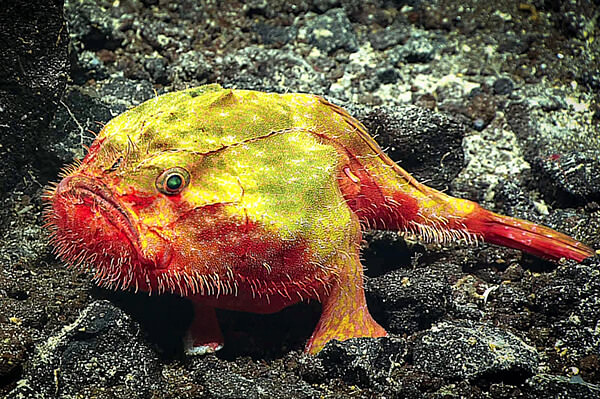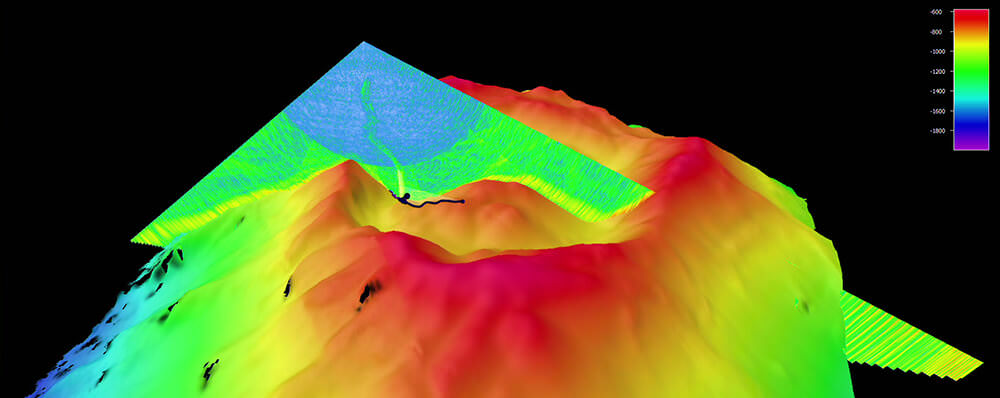Exploring the mesophotic depths of the sanctuary can be challenging. Mesophotic coral ecosystems, sometimes referred to as “twilight reefs,” are found from almost 100 feet to over 490 feet below the ocean’s surface. To study these areas, researchers use special technology such as rebreathers (recycled air scuba diving), remotely operated vehicles, submersibles, autonomous underwater vehicles, and drop cameras.
From 2022 to 2026, a project called the Deep Coral Reef Ecosystem Studies will monitor mesophotic coral ecosystems in Fagatele Bay and conduct exploratory dives in Fagalua/Fogamaʻa, Aunuʻu, Taʻū, and Swains. This project will provide the first monitoring data for three sites and explore areas that have not been visited before. In 2023, National Marine Sanctuary of American Samoa and the NOAA Ship Rainier supported rebreather divers from this project to conduct initial exploratory dives in Taʻū and Swains. The divers collected data on fish, algae, and corals, including using a technique called photogrammetry to create 3D models of the seafloor at each site.

In February 2017, another collaborative effort with National Marine Sanctuary of American Samoa, rebreather divers from Papahānaumokuākea Marine National Monument, the National Centers for Coastal Ocean Science, and the Bishop Museum of Hawaiʻi conducted fish and coral surveys at depths ranging from 250 to 330 feet, documenting a wide variety of species. They collected 104 specimens of black corals and gorgonians, and recorded 118 different species of fish. At the time of discovery, many of these observations were likely new to science.
These efforts provide an exciting glimpse into these poorly understood ecosystems and will provide important insights to guide future management and research.


Much of the habitat within National Marine Sanctuary of American Samoa lies in the deep sea. Despite the lack of light, chilling temperatures, and high pressure, these areas support a variety of life including deep sea corals and sponges, sea stars, crustaceans and more. Reaching depths of up to 16,000 feet or more, these areas are challenging to study and require specialized tools like multibeam sonar, remotely operated vehicles, submersibles, autonomous underwater vehicles, and deep-sea landers.
In February 2017, the NOAA Ship Okeanos Explorer visited American Samoa and conducted deep-sea surveys using the remotely operated vehicles Deep Discoverer and Seirios (also known as ROVs). They explored unknown deep-sea ridges and seamounts, and discovered and documented a wide variety of organisms, many new to science.

In July 2019, another deep-sea expedition took place in sanctuary waters surrounding American Samoa in collaboration with Ocean Exploration Trust and E/V Nautilus. Researchers acquired baseline information on deep-sea and mesophotic habitats in American Samoa, conducted benthic transect surveys and photogrammetry, and explored seamounts.
From August to September 2024, National Marine Sanctuary of American Samoa partnered with Ocean Exploration Trust and NOAA Ocean Exploration to return to American Samoa on an expedition called “E Mamana Ou Gataifale.” The first leg of the expedition focused on the biodiversity of midwater pelagic communities, with a special focus on Vailulu’u Seamount. The second leg of the expedition used ROVs and autonomous underwater vehicles (AUVs) to explore Vailulu’u and Malulu Seamounts as well as other features in the American Samoa EEZ. This leg also deployed an AUV to seek out clues to the wreck of Samoan Clipper.

The deep sea is a harsh environment, typically hospitable to invertebrates; however, these eels have adapted to life near a hydrothermally active site. This photograph was taken in 2005 during an expedition carried out by the Hawaii Undersea Research Laboratory.
The hydrothermally active vents at Vailulu’u release heated water, gasses, and minerals. During the 2019 and 2024 Nautilus expeditions, these vents were investigated using a temperature probe which determined the emissions from the vent can reach up to 415° F.
In addition to the mapping and exploration of the deep sea, an important component of this work is community outreach. In 2024, National Marine Sanctuary of American Samoa partnered with the E/V Nautilus to give local teachers a tour of the ship and the technology that makes new deep-sea discoveries possible.

Dive in to learn more about deep-sea exploration in National Marine Sanctuary of American Samoa over the years! Scroll through the interactive story map to learn about where deep sea expeditions have taken place, including their research objectives, discoveries, and what’s next!